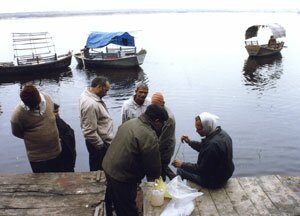|
Residents and local corporators in Kanpur were on warpath as the taps in many localities of this industrial town supplied black, brown, yellow stinking water. In Allahabad, the sadhu fraternity refused to take a holy dip on Mauni Amawasya enraged at government’s callousness to check pollution in Ganga whose water they said was no longer fit for religious ritual.
Two simultaneous agitations. Identical reason.
It is a story of how downstream towns suffer due to activities upstream. There are distilleries, paper, sugar mills and chemical units in Meerut, Rampur, Gajraula Industrial Estate, Moradabad, Bulandsahar and other towns of Western Uttar Pradesh and Uttaranchal which discharge their highly contaminated, multi-coloured waste into the Ram Ganga and Kali rivers, the tributaries of Ganga which meet it in the upstream of Kanpur. The industrial effluents generated by upstream towns aggravate Kanpur’s drinking water problem. In Kanpur, 350-odd leather-making units add to the pollution of the holy river. Resultantly, further down, Allahabad gets more toxic water.
 A beeline of gastro enteritis patients at Kanpur hospitals and the growing ire of the saints at Allahabad made the authorities concerned take stock of the state of affairs. Taking strong note of the situation, the Central Pollution Control Board (CPCB) took samples of the Ganga water at various locations. It was found that the oxygen level in Ram Ganga at Farrukhabad was 0.4 milligram per litre due to which shoals of fish were dying. The CPCB has pointed out that Ram Ganga and Kali are polluted owing to the untreated industrial waste discharged by paper factories, distilleries and other chemical units which have turned the river water black and yellow. Similarly, the Mayor of Kanpur alleges that most upstream districts have closed their treatment plants and so the impact can be seen in the city’s drinking water. Interestingly, the CPCB officials saw deep yellow water in Ram Ganga river in Haldwani district of Uttranchal. However, instead of taking any action against the erring units, the Uttaranchal authorities have washed their hands off the problem. A beeline of gastro enteritis patients at Kanpur hospitals and the growing ire of the saints at Allahabad made the authorities concerned take stock of the state of affairs. Taking strong note of the situation, the Central Pollution Control Board (CPCB) took samples of the Ganga water at various locations. It was found that the oxygen level in Ram Ganga at Farrukhabad was 0.4 milligram per litre due to which shoals of fish were dying. The CPCB has pointed out that Ram Ganga and Kali are polluted owing to the untreated industrial waste discharged by paper factories, distilleries and other chemical units which have turned the river water black and yellow. Similarly, the Mayor of Kanpur alleges that most upstream districts have closed their treatment plants and so the impact can be seen in the city’s drinking water. Interestingly, the CPCB officials saw deep yellow water in Ram Ganga river in Haldwani district of Uttranchal. However, instead of taking any action against the erring units, the Uttaranchal authorities have washed their hands off the problem.
The Uttar Pradesh (UP) government has directed the district magistrates of Farrukhabad, Meerut and Moradabad to initiate action against the sugar mills and distilleries. Already, the cash-starved Kanpur Jal Sansthan (Water Works) is spending Rs 50,000 extra everyday in purification of highly polluted raw water from Ganga. Acting General Manager and Secretary of Jal Sansthan RS Tiwari said that unless the pollutants are tapped from being released in the mainstream, the Sansthan will face a financial crunch and may be forced to stop water purification process. Sources say that the Jal Sansthan has been, of late, using alum and liquid chlorine at the rate of 80 to 90 kgs in place of 20 to 30 kgs per hour. Jal Sansthan authorities opine that the effluents released in the upstream would impact the raw water source of Kanpur for many days. Even if the pollutants released upstream are tapped today, it would take at least five days before Kanpur’s tryst with contaminated water ends.
Meanwhile the protesting sants at Allahabad have noted that they would take more stringent steps to restore the glory of Ganga. Saints like Shankaracharya of Jyotirmath, Swami Swaroopanand Saraswati and Swami Nischalanand of Puri have said that if the situation is not salvaged, their agitation would mount. The Shankaracharya of Puri warned that a time would come when the people of this country would not even like to spit on the politicians and factory owners who have ganged up to pollute the holy river. Some sadhus have started fast-unto-death to press their demand of a pollution-free Ganga. A few threatened self-immolation and created human chains along the riverside. They scored a partial victory when acting on a Public Interest Litigation (PIL) filed by the Mahant of Kabir Ashram Guruvachan Das, the Allahabad High Court directed the UP government to stop pollution of Ganga caused by the leather manufacturers in Kanpur and release water from the Narora barrage. However, Executive Secretary of Eco Friends Rakesh Jaiswal says that the present crisis of Ganga pollution is a direct fallout of the release of a cocktail of industrial effluents by units upstream of Kanpur. But, it seems, Ganga pollution has become synonymous with tannery waste. And hence the saints’ anger targeting the leather-making units and the subsequent Allahabad High Court order. He added that instead of taking action against the real culprits, the authorities are still groping in the dark.
|
